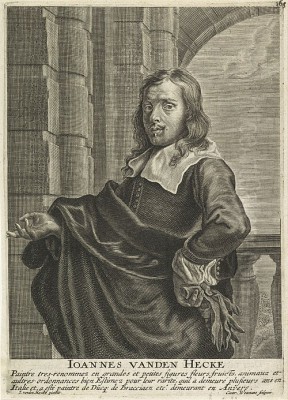
Jan van den Hecke the Elder stands as a significant, if sometimes overlooked, figure in the rich tapestry of Flemish Baroque art. Active during a period of immense artistic innovation and production in the Southern Netherlands, he carved out a distinguished career primarily as a painter of exquisite still lifes, particularly flower pieces and sumptuous displays, as well as evocative landscapes. His work reflects both the technical brilliance and the thematic concerns of his era, demonstrating a keen eye for detail, a sophisticated understanding of composition, and a mastery of color and texture.
Early Life and Artistic Formation in Antwerp
The precise birth year of Jan van den Hecke the Elder is subject to some scholarly debate, with sources suggesting either circa 1620 or 1625. He was born in Quaremonde (Kwaremont), a village near Oudenaarde in East Flanders. This region, part of the Spanish Netherlands at the time, was a vibrant cultural hub, with Antwerp serving as its artistic epicenter. It was to Antwerp that the young van den Hecke would gravitate to pursue his artistic training.
In 1636, he is documented as an apprentice in the Antwerp Guild of Saint Luke, the city's powerful and prestigious organization for painters, sculptors, and other craftsmen. His master was Abraham van den Ackeryer (also sometimes recorded as Abraham van den Hove), a painter about whom less is known today but who evidently provided van den Hecke with a solid foundation in the prevailing artistic techniques. During his apprenticeship, he would have been exposed to the works of Antwerp's leading masters and the diverse specializations flourishing in the city, from monumental history paintings to intimate genre scenes. It is also noted that he had close associations with his contemporary, Honorius Gallus (also known as Herius Galleries).
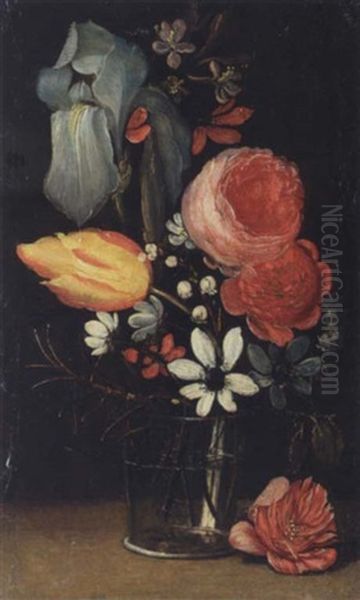
By 1641, Jan van den Hecke had achieved the status of a master in the Guild of Saint Luke, a crucial step that allowed him to establish his own workshop, take on pupils, and sell his works independently. This marked the official beginning of his professional career in a city teeming with artistic talent, including luminaries such as Jacob Jordaens and David Teniers the Younger, who were shaping the course of Flemish art in the wake of Peter Paul Rubens's towering influence.
The Italian Interlude and Its Impact
Like many Northern European artists of his time, Jan van den Hecke recognized the immense value of an Italian sojourn. Italy, particularly Rome, was considered the ultimate finishing school for artists, offering unparalleled opportunities to study classical antiquity and the masterpieces of the Italian Renaissance and contemporary Baroque. Van den Hecke is believed to have traveled to Italy in the early 1650s, spending a significant period there, possibly from around 1653 to 1658 or even as late as 1665, before returning more permanently to the North, though he may have made subsequent trips.
During his time in Rome, he reportedly received patronage from Paolo Giordano II Orsini, the Duke of Bracciano, a notable art collector and patron. This connection would have provided him with both financial support and access to influential artistic circles. In Rome, he would have encountered the works of Italian masters such as Caravaggio and his followers, the Carracci, and contemporary Baroque painters. He would also have seen the flourishing genre of still life painting in Italy, with artists like Mario Nuzzi, known as Mario de' Fiori, specializing in flower pieces. The experience of Italian light, color, and artistic traditions undoubtedly enriched his palette and compositional strategies. He may also have come into contact with the Bamboccianti, a group of mostly Dutch and Flemish genre painters active in Rome, such as Michelangelo Cerquozzi, known for their depictions of everyday Roman life.
Mature Career: Specializations and Style
Upon his return to the Southern Netherlands, primarily basing himself in Antwerp but also possibly spending time in Brussels, Jan van den Hecke the Elder consolidated his reputation. He became particularly renowned for his still lifes, a genre that enjoyed immense popularity among the increasingly affluent merchant class and aristocracy.
Flower Still Lifes
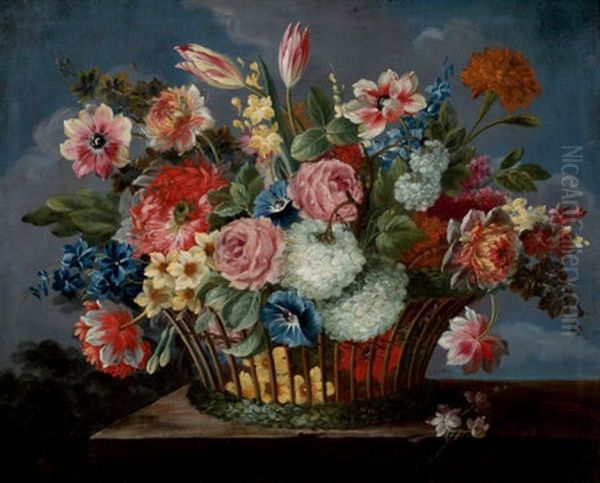
Van den Hecke's flower paintings are characterized by their elegance, meticulous detail, and vibrant yet harmonious color schemes. He often depicted bouquets in ornate vases, sometimes glass, sometimes porcelain or metal, showcasing his skill in rendering different textures. Works like "Flower still life in a glass vase" and "Flower basket" (believed to have been painted between 1640 and 1684) exemplify his ability to capture the delicate beauty of individual blooms – tulips, roses, irises, and carnations, among others – while arranging them into lush, balanced compositions. These paintings were not merely decorative; they often carried symbolic meanings (vanitas themes of transience, or allusions to Marian devotion), and they demonstrated the artist's scientific interest in botany, a common trait in the period. His contemporaries in this field included such masters as Jan Philips van Thielen and Nicolaes van Verendael, who also worked in Antwerp, and further north in the Dutch Republic, artists like Jan Davidsz. de Heem (who also worked in Antwerp for a period) and Rachel Ruysch were creating breathtaking floral displays.
Pronkstilleven and Paintings of Precious Objects
Beyond flowers, van den Hecke excelled in the pronkstilleven, or sumptuous still life, a subgenre that celebrated wealth and abundance through the depiction of luxurious objects. He was particularly adept at rendering the reflective surfaces of gold, silver, and pewter vessels, the transparency of crystal glassware, and the delicate sheen of Chinese porcelain – all highly prized commodities at the time. These compositions often included fruits, game, and rich textiles, creating a feast for the eyes. His skill in this area rivaled that of specialists like Willem Kalf in the Dutch Republic or Adriaen van Utrecht in Antwerp. The meticulous rendering of these objects spoke to the technical virtuosity of the artist and the sophisticated tastes of his patrons.
Landscape Painting
While perhaps best known for his still lifes, Jan van den Hecke the Elder was also a capable landscape painter. His landscapes often depict idyllic pastoral scenes, sometimes with figures and animals, or more rugged, Italianate vistas, likely inspired by his travels. These works show an understanding of atmospheric perspective and a sensitivity to the nuances of light and shadow. The tradition of landscape painting was strong in Flanders, with earlier masters like Jan Brueghel the Elder and Joos de Momper having established a rich legacy. Van den Hecke's landscapes would have also been informed by the work of contemporaries and those who, like Paul Bril, had spent considerable time in Italy. Some sources suggest he painted landscapes that included animals and other elements, showcasing a versatility that extended beyond pure still life.
Influences and Artistic Connections
The towering figure of Peter Paul Rubens, who had died in 1640, cast a long shadow over Flemish art for decades. While van den Hecke was not a direct pupil, it is noted that his work, particularly in the rendering of human heads (perhaps in figured landscapes or allegorical still lifes), clarity of form, and use of color, shows an assimilation of Rubenesque principles. This suggests an artist keenly aware of the dominant artistic currents of his time and capable of integrating them into his own distinct style.
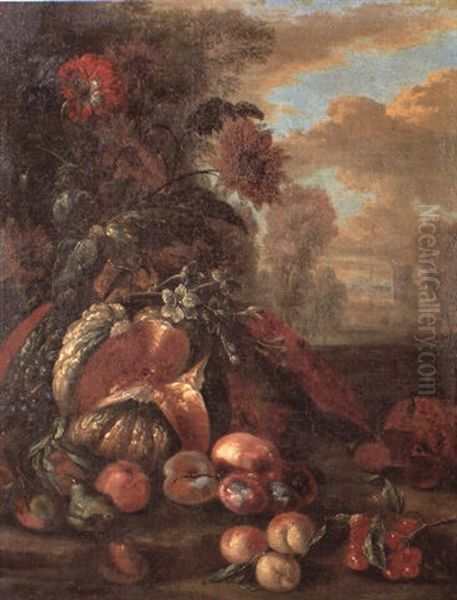
His association with Honorius Gallus in his early years, and his training under Abraham van den Ackeryer, placed him within the active network of Antwerp's artistic community. The Guild of Saint Luke itself fostered a competitive yet collaborative environment where artists could learn from one another. His travels to Italy would have further expanded his artistic horizons, exposing him to a different set of influences and allowing him to engage with the international artistic community present in Rome.
Patronage and Notable Works
Jan van den Hecke's talent did not go unnoticed by high-ranking patrons. It is recorded that he worked for Archduke Leopold Wilhelm of Austria, who was Governor of the Spanish Netherlands from 1647 to 1656 and a renowned art collector. The Archduke's collection, famously depicted by David Teniers the Younger, was one of the finest in Europe. Serving as a court painter, even if not in a permanent, exclusive capacity, would have been a significant honor and provided van den Hecke with important commissions. One such work mentioned is a historical painting, "Saint Francis with the Virgin Mary and Child," indicating his capabilities extended to religious subjects, a common requirement for artists of the period. He is also said to have worked for the Pope, though specific details of this patronage are less clear.
While a comprehensive list of all his surviving works is extensive and subject to ongoing art historical research, key examples that illustrate his prowess include:
"Flower still life in a glass vase": A testament to his delicate touch with floral subjects and his ability to render transparent materials.
"Flower basket": Another example of his floral compositions, showcasing variety and naturalism.
Garlands of Flowers around a Cartouche: A popular subgenre where a central image (often religious, mythological, or a portrait) is framed by an elaborate floral garland. Van den Hecke, like Daniel Seghers and Jan Brueghel the Younger, excelled in these collaborative-style pieces, though he often painted the entire work himself. An example is "Garland of Flowers around a Cartouche with the Holy Family."
Pronkstillevens featuring metalware, fruit, and game: These works highlight his skill in depicting a variety of textures and his ability to create opulent, visually engaging compositions.
His paintings are now found in numerous prestigious museums, including the Royal Museums of Fine Arts of Belgium in Brussels, and in private collections worldwide, a testament to their enduring appeal.
Anecdotes and Artistic Persona
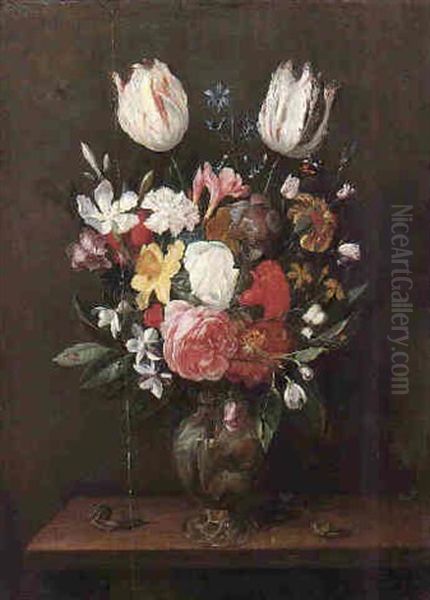
Art historical records sometimes offer glimpses into an artist's working methods or personality. For Jan van den Hecke, it's noted that his still lifes sometimes incorporated elements like Oriental carpets and musical instruments, adding to their exoticism and richness. The inclusion of live animals and vegetables in some still life compositions also points to a desire to animate these scenes and perhaps imbue them with further symbolic layers.
The discrepancy in his birth year (1620 vs. 1625) is a common challenge in researching artists from this period, where record-keeping was not always precise. His death in Antwerp in 1684 is more consistently documented.
Family and Artistic Succession
The artistic tradition in the van den Hecke family did not end with Jan the Elder. He had at least two sons who also became painters. Jan van den Hecke II followed in his father's footsteps, becoming a popular painter specializing in flowers and birds, thereby continuing the family's contribution to these genres. Another son, mentioned in some sources as Pieter de Koninck van den Hecke, is also noted as a still life painter, suggesting a strong familial inclination towards this meticulous art form. This continuation of artistic practice within families was a common feature of the early modern period, with skills and workshop practices often passed down from father to son.
Art Historical Position and Legacy
Jan van den Hecke the Elder holds a respected position within the Flemish Baroque school. He was a master of his chosen genres, contributing significantly to the development and popularity of still life painting in the 17th century. His works are admired for their technical refinement, aesthetic beauty, and the sophisticated interplay of light, color, and texture.
His ability to absorb influences from both his native Flemish tradition and his Italian experiences allowed him to forge a style that was both accomplished and appealing. While perhaps not as revolutionary as some of his contemporaries like Rubens or Rembrandt van Rijn in the Dutch Republic, van den Hecke represents the high level of quality and specialization that characterized much of Baroque art production.
The occasional academic disputes over the attribution of certain works – with some pieces potentially being confused with those of Peter Paul Rubens or a Cornelis van den Hecke (possibly a relative or another artist of the same name) – highlight the complexities of connoisseurship for this period. However, these debates also underscore the quality of the works in question, deemed worthy of such scrutiny.
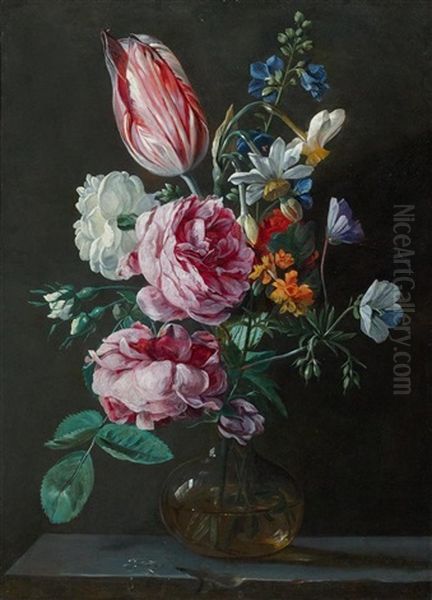
His influence, while perhaps not dramatically widespread, would have been felt by his pupils and younger contemporaries in Antwerp. More broadly, the enduring appeal of his paintings, which continue to be sought after by collectors and admired in museums, speaks to his lasting contribution to the visual culture of the Baroque era. He successfully captured the opulence, intellectual curiosity, and artistic finesse of his time.
Conclusion
Jan van den Hecke the Elder was a highly skilled and versatile Flemish Baroque artist who excelled in the realms of still life and landscape painting. From his formative years in Antwerp's vibrant artistic milieu to his enriching experiences in Italy, he developed a refined style characterized by meticulous detail, rich color, and sophisticated composition. His depictions of flowers, luxurious objects, and evocative scenes not only catered to the tastes of his patrons, including figures like Archduke Leopold Wilhelm, but also contributed to the rich artistic legacy of the 17th century. Though debates about specific attributions or the exact details of his biography may continue, his surviving body of work firmly establishes him as a master of Baroque splendor, whose art continues to captivate viewers with its beauty and technical brilliance.